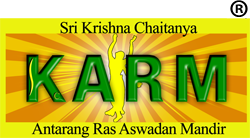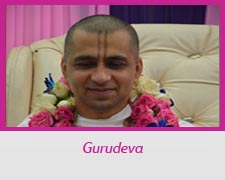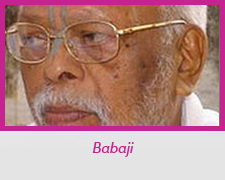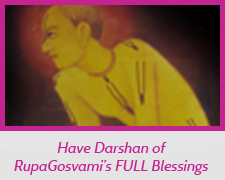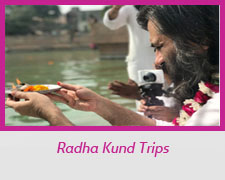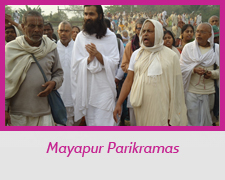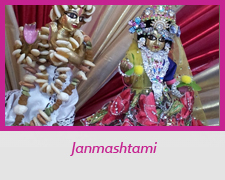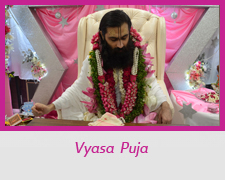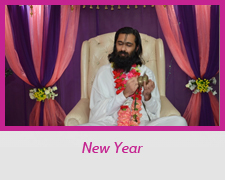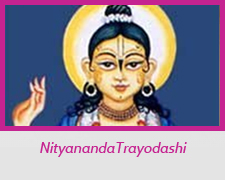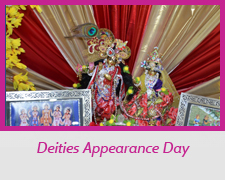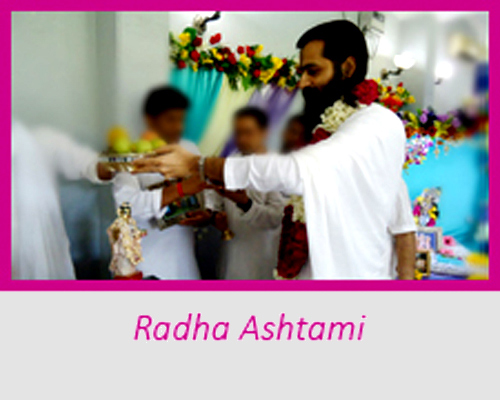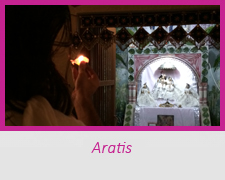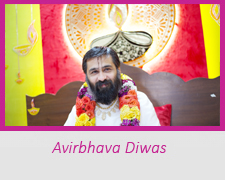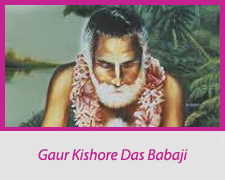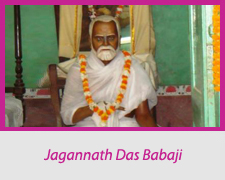FAQs
Q1)What is the main goal of doing bhakti?
A1) Bhakti is the loving devotional service of the Lord. By saying, “the main goal of bhakti”- is like belittling the supremely pure process.
The ONLY goal of Bhakti is rendering loving devotional service to the Lord.
Q2)What are the different types of bhakti?
A2) Caitanya Caritämåta states about the types of Bhakti-
ei ta sādhana-bhakti — dui ta’ prakāra
eka ‘vaidhī bhakti’, ‘rāgānugā-bhakti’ āra
(C.C. Madhya 22.108)
Bhakti is of two types-
- Vaidhi Bhakti and
- Rägänugä Bhakti.
The word Vaidhi comes from the word “Vidhi” which means because of Scriptural Injunctions, i.e., Bhakti performed out of fear of scriptural injnctions- “if I don’t do bhakti (become servant of the Lord), I will go to hell”, “to cross over the ocean of birth and death, I should do bhakti” is Vaidhi Bhakti.
Rägänugä Bhakti- Rägänugä is a composition of two words- Räga and anugä.
Räga means a loving attachment for the Lord and anugä means that which is done to acquire that same loving attachments. Thus, bhakti done in änugatya of the particular raga or bhakti done to have same kind of loving attachment is called Räga-nugä Bhakti.
Q3)How is vaidhi märga different from ‘räga märga’?
A3) Difference ::
| Vaidhi Märga | Räga Märga | |
| Definition | Bhakti performed out of fear of scriptural injunctions. | Bhakti performed purely out of desire in the heart to do so. |
| Attainment |
vidhi-mārge nā pāiye vraje kṛṣṇa-candra (C.C. Madhya 8.226)
One cannot obtain Kåñëa in Goloka Våndävana by serving Him in Vaidhé märga of awe and reverence.
|
rāgānuga-mārge tāṅre bhaje yei jana Only those sädhakas, who worship the Lord on the Rägänugä path, attain the son of Nanda Mahäräja in Vraja.
|
Q4) Can a sädhaka initially doing vaidhi bhakti turns automatically into a rägänugä bhakti?
A4) No. Vaidhi bhakti and Rägänugä Bhakti are two totally different ways of doing bhakti. Caitanya Caritämåta states about the types of Bhakti-
ei ta sādhana-bhakti — dui ta’ prakāra
eka ‘vaidhī bhakti’, ‘rāgānugā-bhakti’ āra
(C.C. Madhya 22.108)
Bhakti is of two types-
- Vaidhi Bhakti and
- Rägänugä Bhakti.
The way jacket cannot become sweater, and sweater cannot become jacket. Both were different, are different and will always remain different. Likewise, Vaidhi Bhakti and Rägänugä Bhakti were, are and will always remain different.
Q5) Räga Märga starts before or after…anartha nivåtti ??
A5) It is often propagated that the conjugal affairs of the Divine Couple is not fit for the devotees to study or practice until they are free from anarthas, as there is a fear of mundane sexual agitation arising from it. It is a misconception.
Whether one does Vaidhé bhakti or Räga bhakti, the conditioned soul will be impure in the beginning.
Scriptures clearly state in this context-
In Çrémad Bhägvatam, in the concluding verse of the Räsa lélä, Çréla Çukadeva says :
vikrīḍitaṁ vraja-vadhūbhir idaṁ ca viṣṇoḥ
śraddhānvito ’nuśṛṇuyād atha varṇayed yaḥ
bhaktiṁ parāṁ bhagavati pratilabhya kāmaṁ
hṛd-rogam āśv apahinoty acireṇa dhīraḥ
(S.B. 10.33.39)
Anyone, who faithfully hears and describes the pastimes of Çré Kåñëa with the Vraja Gopés, will attain supreme devotion to God and will soon become free from the heart’s disease of lust.
Çréla Jéva Gosvämé says :
atra tu hådrogäpahänät pürvam eva parama bhakti präptiù tasmät parama balavad evedam sädhanäm iti bhävaù
(Laghu Toñané Öékä)
The fact that the attainment of the highest bhakti is mentioned before the destruction of lust shows that hearing and chanting of the Räsa Pastimes of Kåñëa and the gopés is the most powerful spiritual practice. First the lamp of love is kindled and then the darkness of lust and ignorance is destroyed.
Çréla Viçvanätha Cakravarté Öhäkura uses the same Bhägvatam çloka in Mädhurya Kädambiné to tell the innocent sädhakas that käma or lust is conquered through attraction to hearing Çré Kåñëa’s madhura léläs. His opinion is- “As a result of hearing these madhura léläs, they act as the very cause for destroying lust. Spiritual käma (thirst to serve Çré Yugala) destroys the lust in one’s heart. This is the spiritual and permanent way of uprooting anarthas like lust. This higher taste destroys all the lower tastes which a devotee fails to overcome.”
Çréla Kaviräja Gosvämé presents Çréman Mahäprabhu’s mukhämåta in context to this important verse; (the concluding verse for Räsa lélä).
vraja-vadhū-saṅge kṛṣṇera rāsādi-vilāsa
yei jana kahe, śune kariyā viśvāsa
hṛd-roga-kāma tāṅra tat-kāle haya kṣaya
tina-guṇa-kṣobha nahe, ‘mahā-dhīra’ haya
(C.C. Antya 5.45-46)
When one faithfully speaks or hears the pastimes like räsa–lélä with the gopés, then the disease of heart, lust and mental agitation etc., caused by the three modes of material nature, are immediately destroyed and hence the unsteadiness or the flickering of the mind completely vanishes and the person/aspirant becomes completely sober. This is the all-auspicious nature of the léläs which cleanses his heart by acting as a purifying agent.
Narottama Däsa Öhäkura advices the same in Çré Prema Bhakti Candrikä, rasika bhakata saìge..lélä rasa sadä gäna (PBC Verse 99 and 100). Continuously hear these nectarine léläs in the association of rasika saints (expert in tattva jïäna, lélä and äcaraëa), those who truly know the essence of these léläs, the true tattva darçés. Sadä means always Always ALWAYS (without any break).
Çréla Narottama Däsa Öhäkura also mentions in Guru Vaìdanä-
prema bhakti yāhā hoite, avidyā vināśa yāte
(PBC Verse 5)
Öhäkura Mahäçaya explicitly tells avidyä (lust etc.) goes due to prema bhakti. When prema bhakti enters in the heart of devotee, all kinds of avidyä goes. He doesn’t mention ‘avidyä näça hoite, then you start with prema bhakti.
Q6) Can a jéva fall back from Goloka after getting liberated?
A6) No!! A jéva can enter into Goloka, the Land of love, ONLY after getting rid off all anarthas (lust, anger, greed, jealousy, enviousness, delusion). So, there is no scope of falling back. Although by the will of the Lord, liberated souls do come in the material world to deliver the fallen souls.
Q7) What Mahäprabhu came to give ?
A7) There are three reasons (desires) behind Çré Kåñëa’s descent as Gaura.
Çré Svarüpa Dämodara has described the three desires:
- How glorious is Çré Rädhä’s Love for Me ?
- How does Çré Rädhä relishes My wonderful Sweetness ?
- How much happiness Çré Rädhä feels when She relishes My Sweetness ?
Çréla Narottama Däsa Öhäkura describes in Çré Prema Bhakti Candrikä-
tina väïchä abhiläñé, çacé garbhe parakäçi,
saìge saba pariñada gaëa
(Verse 113)
Having three divine desires, He manifested Himself in the womb of Mother Çacé along with His Eternal Associates.
Çréla Rämänanda Räya tells Çré Gauräìga -
nija-gūḍha-kārya tomāra — prema āsvādana
ānuṣaṅge prema-maya kaile tribhuvana
(C.C. Madhya 8.280)
The very confidential reason of Your descend is to relish the super excellent Çré Rädhä Prema and as a secondary objective You fill the three worlds with Prema (same prema).
Q8) What are the main reasons for the advent of Çréman Mahäprabhu?
A8) There are three reasons (desires) behind Çré Kåñëa’s descent as Gaura.
Çré Svarüpa Dämodara has described the three desires:
- How glorious is Çré Rädhä’s Love for Me ?
- How does Çré Rädhä relishes My wonderful Sweetness ?
- How much happiness Çré Rädhä feels when She relishes My Sweetness ?
Çréla Narottama Däsa Öhäkura describes in Çré Prema Bhakti Candrikä-
tina väïchä abhiläñé, çacé garbhe parakäçi,
saìge saba pariñada gaëa
(Verse 113)
Having three divine desires, He manifested Himself in the womb of Mother Çacé along with His Eternal Associates.
Çréla Rämänanda Räya tells Çré Gauräìga -
nija-gūḍha-kārya tomāra — prema āsvādana
ānuṣaṅge prema-maya kaile tribhuvana
(C.C. Madhya 8.280)
The very confidential reason of Your descend is to relish the super excellent Çré Rädhä Prema and as a secondary objective You fill the three worlds with Prema (same prema).
Q9) Why is Çréman Mahäprabhu also known as ‘Dätä Çiromaëé’?
A9) Çréla Rämänanda Räya tells Çré Gauräìga -
nija-gūḍha-kārya tomāra — prema āsvādana
ānuṣaṅge prema-maya kaile tribhuvana
(C.C. Madhya 8.280)
The very confidential reason of Your descend is to relish the super excellent Çré Rädhä Prema and as a secondary objective You fill the three worlds with Prema (same prema).
Çréla Rüpa Gosvämé knowing the innermost desire of the Lord tells Çréman Gauräìga Mahäprabhu’s contribution to the fallen people of this age-
anarpita-carīṁ cirāt karuṇayāvatīrṇaḥ kalau
samarpayitum unnatojjvala-rasāṁ sva-bhakti-śriyam
hariḥ puraṭa-sundara-dyuti-kadamba-sandīpitaḥ
sadā hṛdaya-kandare sphuratu vaḥ śacī-nandanaḥ
(Vidagdha Mädhava 1.2)
May the Supreme Lord, who is known as Çré Çacénandana, whose form is dazzling like molten gold, be transcendentally situated in the innermost chamber of your heart. By His causeless mercy, He descended in the age of kali to give what had not been bestowed before: “the highest aspect of madhura prema rasa.”…maïjaré bhäva, the service of Çrématé Rädhäräné.
Çrutis, daëòakäraëye åñiç attained perfection in gopé bhäva. This kind of perfection/attainment existed earlier as well but here Çréman Mahäprabhu is not referring to gopé bhäva. The rasa which Mahäprabhu is pin-pointing here is the very special form of devotional service, where the object of service is not Çré Kåñëa alone. Both Çré Kåñëa and Çrématé Rädhäräné i.e.,Yugala Sarkära are the object of service.
This Maïjaré Bhäva is the unique gift of His causeless mercy, which Mahäprabhu has come to give to all living entities of this kaliyuga, irrespective of their fallen condition.
The vine of devotion that Çréman Mahäprabhu gave to the people of this world yields the fruits of brilliant rasa, the amorous love of Vraja, particularly of the most confidential personal service of Çrématé Rädhäräné, named Maïjaré Bhäva Sädhanä.
This Rädhä däsyaà is the gift of Çréman Mahäprabhu’s munificence. He gave to all fallen souls what He Himself relished, and by His Mercy, Çréväsa Paëòita, Advaita Äcärya also relished. Çréla Kåñëa Däsa therefore aptly called Çréman Mahäprabhu as “Dätä Çiromaëi”
āpane kari’ āsvādane, śikhāila bhakta-gaṇe,
prema-cintāmaṇira prabhu dhanī
(C.C. Madhya 2.81)
Q10) Mahäprabhu relishing Maïjaré bhäva- (Did Mahäprabhu relish Maïjaré bhäva?)
A10) Yes, Mahäprabhu relished maïjaré bhäva.
After Kåñëa became Gaura to taste the Love that Rädhä feels for Him, He also wanted to experience the nectar of the kiìkarés’ service.
Çré Caitanya Caritämåta describes Çréman Mahäprabhu’s words after He came out of the highest bliss i.e. relishing Maïjaré Bhäva, His kürmäkåti form.
ihāṅ haite āji mui genu govardhane
dekhoṅ, — yadi kṛṣṇa karena godhana-cāraṇe
govardhane caḍi’ kṛṣṇa bājāilā veṇu
govardhanera caudike care saba dhenu
veṇu-nāda śuni’ āilā rādhā-ṭhākurāṇī
saba sakhī-gaṇa-saṅge kariyā sājani
rādhā lañā kṛṣṇa praveśilā kandarāte
sakhī-gaṇa kahe more phula uṭhāite
(C.C. Antya 14.106-109)
“Today I want to go to Govardhana hill”, Çré Caitanya Mahäprabhu said, “to see if Kåñëa was tending his cows there. Climbing on Govardhana hill, Kåñëa played His flute surrounded by the cows. Hearing the flute song, Çrématé Rädhikä came there. Oh Sakhé! I cannot describe Her form and mood ! Kåñëa took Rädhikä by the hand and entered the cave with Her, while the Sakhés told Me (Mahäprabhu as Maïjaré) to pick some flowers.”
We can see here that Çréman Mahäprabhu finally came to relish the mood of the Çrématé’s Maïjarés (maidservants) at the pinnacle of ecstatic absorption. Sakhés like Lalitä, Viçäkhä tell maïjarés to pluck flowers for Çré Yugala. Here, the sakhés told Çréman Mahäprabhu (as a Maïjaré) to pluck flowers for Çré Çré Rädhä Mädhava.
And when Çréman Mahäprabhu was almost drowned in the ocean of ecstasy, and all the joints of His bones became disconnected because of ecstasy, He told His devotees in ardha-bähya daçä (half external consciousness)-
kālindī dekhiyā āmi gelāṅa vṛndāvana
dekhi, — jala-krīḍā karena vrajendra-nandana
rādhikādi gopī-gaṇa-saṅge ekatra meli’
yamunāra jale mahā-raṅge karena keli
tīre rahi’ dekhi āmi sakhī-gaṇa-saṅge
eka-sakhī sakhī-gaṇe dekhāya sei raṅge
(C.C. Antya 18.80-82)
“Seeing Yamunä river, I want to go to Våndävana, where I saw the prince of Vraja, Kåñëa, playing in the water with Çré Rädhikä and the gopés, and having great fun. I stayed on the shore with other sakhés.” Here again Çréman Mahäprabhu explains He was relishing in the mood of the Maïjarés on the shore, witnessing those sweet pastimes.(sakhés participate in jala-keli. Maïjarés relish these pastimes from the shore only. They don’t indulge directly in jala-keli).
Maïjarés are completely satisfied when they see the Yugala happy. So Çréman Mahäprabhu also expressed complete satisfaction in Maïjaré Bhäva. Upon viewing the jala-keli pastimes of the Lord Kåñëa with Çré Rädhä and other gopés, Çréman Mahäprabhu humbly said-
yāhā kari’ āsvādana, ānandita mora mana,
netra-karṇa-yugma juḍāila
(C.C. Antya 18.99)
This sight is giving great pleasure to My mind, as My eyes and ears have both become completely satisfied.
Çrématé Rädhikä and the other gopés always taste the nectar of Çré Kåñëa’s attributes, His Madana-Mohana rüpa, His sweetness, His captivating flute, His words, His voice which reminds rumbling rain cloud, His jingling ornaments which alive the ears, His remnants, fragrance of Çyäma’s body and the touch of His cooling body. Çréman Mahäprabhu says after they enjoy- “My five senses beg for their nectarine remnants, ever remaining their submissive disciples.”
kṛṣṇa-guṇa-rūpa-rasa, gandha, śabda, paraśa,
se sudhā āsvāde gopī-gaṇa
tā-sabāra grāsa-śeṣe, āni’ pañcendriya śiṣye,
se bhikṣāya rākhena jīvana
(C.C. Antya 14.49)
Few other verses in which Çréman Mahäprabhu in ardha-bähya daçä, is again cherishing Maïjaré bhäva-
saṅge lañā sakhī-gaṇa, rādhā kailā bhojana,
duṅhe kailā mandire śayana
keha kare vījana, keha pāda-samvāhana,
keha karāya tāmbūla bhakṣaṇa
rādhā-kṛṣṇa nidrā gelā, sakhī-gaṇa śayana kailā,
dekhi’ āmāra sukhī haila mana
( CC Antya 18.107-108)
“Çrématé Rädhikä and Her gopé friends took remnants of Çré Kåñëa’s Prasädam. Then Rädhä and Kåñëa laid down in their çayana mandira. Someone began to fan Them, while other massaged Their feet. Some fed Them päna to chew. When Rädhä and Kåñëa fell asleep, all the gopés also took rest. Seeing this My mind became very happy.”
Q11) What Six Gosvämés preached and practiced?
A11) Six Gosvämés of Våndävana… What they practised and preached !
vrajera nigūḍha bhakti karila pracāra
(C.C.Madhya 1.34)
Çréla Sanätana Gosvämé and Çréla Rüpa Gosvämé and rest of the six Gosvämés of Vraja practised räga bhajana and preached the same. They gave what they tasted. These Mahäjanas and their followers till now have only practised räga bhakti and have preached the same. They never practised Vaidhé bhakti, never encouraged anyone to do so in this supremely merciful period of the Dätä Çiromaëi (The Supreme Donor) Çré Gauräìga Mahäprabhu.
Çré Rüpa Gosvämé is the Ädi Guru. Bonafide followers of Çré Rüpa Gosvämé will only practice and preach vraja nigüòha bhakti. One, who is not preaching pure nigüòha bhakti of Vraja, cannot be a bonafide follower of Çré Rüpa Gosvämé. His mercy flows in his books such as Ujjvala Nilmaëi, Vidagdha Mädhava, Lalita Mädhava Dänakeli kamüdi etc.
Mahäprabhu inspired Çré Rüpa Gosvämé from within to write this lélä-kävya, because only by reading such nigüòha pastimes, hankering for Vraja prema bhakti is bound to awaken in the hearts of the future generation of devotees.
Narottama Däsa Öhäkura explains in the Verse 9 of Prema Bhakti Candrikä-
prema bhakti réti yoto, nija granthe suvekata
likhiyächen dui mahäçaya
yähära çravaëa hoite, premänande bhäse cite,
yugala madhura rasäçraya
(Verse- 9)
Çré Rüpa and Çré Sanätana Gosvämés’ numerous writings have explained the essence of prema bhakti. By hearing, one’s mind will surely experience Yugala madhura rasa and float in premänanda.
Six Gosvämés especially Çré Rüpa and Çré Sanätana Gosvämé have descended to the earth with Çréman Mahäprabhu as His associates to preach the practise of Vraja rasa sädhanä. Çré Rüpa-Sanätana are Lord’s Eternal Associates in Vraja named Çré Rüpa Maïjaré and Çré Lavaìga Maïjaré.
nana çästra vicäraëaika nipuëau
sad-dharma saàstäpakau
lokänäm hita käriëau tri-bhuvane
mänyau çaraëyäkarau
(Saò-Gosvämé Açtakam- 2)
The Gosvämégaëa, who are very expert in çästras, established the eternal principle of worship for all human beings. Here, the word mentioned is ‘loke’, this has been used for all the people of this world and not just for devotees. Had this Maïjaré bhäva only for devotees, the word ‘bhaktye’ would have been used. The word ‘loke’ reveals that this maïjaré bhäva is for all jévas of kali yuga. The madhura léläs of Yugala Sarkära is for the entire humanity (still having anarthas), and not just for devotees. We should see, understand and follow what six Gosvämés practised, broadcasted, meditated and wrote.
säòe säta prahara yäya kértana-smaraëe
(C.C. Antya 6.310)
Çréla Raghunätha Däsa Gosvämé remembered the madhura léläs of Rädhä and Kåñëa daily for 22 ½ hours.
ei chay goçäir jabe braje koilä bäs
rädhä-kåñëa-nitya-lélä korilä prakäça
(Prärthnä, Çré Narottama Däsa Öhäkura)
Residing in Vraja, the Six Gosvämés revealed, broadcasted the añöa-yäma nitya lélä of Çré Çré Rädhä and Kåñëa (eightfold daily pastimes). Granthas by Rüpa-Sanätana are of Mädhurya rasa. They revealed- rädhä-kåñëa-nitya-lélä korilä prakäç, and they instruct us to do the same.
Q12) What is Maïjaré Bhäva Sädhanä?
A12) By Çréman Mahäprabhu’s causeless mercy, He descended in the age of kali to give what had not been bestowed before: “the highest aspect of madhura prema rasa.”…maïjaré bhäva, the service of Çrématé Rädhäräné.
Çrutis, daëòakäraëye åñiç attained perfection in gopé bhäva. This kind of perfection/attainment existed earlier as well but here Çréman Mahäprabhu is not referring to gopé bhäva. The rasa which Mahäprabhu is pin-pointing here is the very special form of devotional service, where the object of service is not Çré Kåñëa alone. Both Çré Kåñëa and Çrématé Rädhäräné i.e.,Yugala Sarkära are the object of service.
This Maïjaré Bhäva is the unique gift of His causeless mercy, which Mahäprabhu has come to give to all living entities of this kaliyuga, irrespective of their fallen condition. ‘He is giving’ means there is a possibility of giving the highest bhäva, the highest rasa, and also the possibility of receiving the highest rasa for all living entities if one takes up the practise (the right sädhanä) from the bonafide Lineage of Mahäprabhu. Unless one is really unfortunate (manda-bhägya -S.B.), a devotee will not be bereft of this topmost gift of Maïjaré Bhäva in this age.
The vine of devotion that Çréman Mahäprabhu gave to the people of this world yields the fruits of brilliant rasa, the amorous love of Vraja, particularly of the most confidential personal service of Çrématé Rädhäräné, named Maïjaré Bhäva Sädhanä.
Before descension of Çréman Mahäprabhu nobody knew the secret of the sweet devotional love of the Gopés for Krñëa, what to speak of the topmost ‘mädana mahäbhäva’ of Çré Rädhä, the crown jewel of all the Gopés.
The wish yielding vine of devotion revealed by Mahäprabhu is also hidden in Vedas. Some Gopés who were the presiding Deities of the Vedas also attained Kåñëa’s lotus feet in Mädhurya rasa(Vämana Puräna). But even they left their ecstatic attainment hidden in the baskets of their hearts, that’s why it is said “çruter güòham”: “it is hidden in Vedas.”
In the pre – Caitanya era, there was a cult of sakhé bhäva (love for Krñëa as an amorous consort) preached by great saints like, poet Jayadeva, Candi däsa, Vidyäpati, Bilvamaëgala and others….but the Maïjaré Bhäva Sädhanä, the personal and exclusive service of Çré Rädhä, was a new gift, introduced by Çré Gaurasundara.
The goal of the Gauòéya Vaiñëavas is Rädhä-däsya, Maïjaré Bhäva. Gauòéya Vaiñëavas just breathe Rädhä däsya 24*7. This is the most merciful gift of Çréman Mahäprabhu and the dearmost subject preached by the six Gosvämés. According to the Gosvämés, this is the greatest, the most superlative and the most extraordinary goal of life. This is the highest step on the staircase of advancement to the Spiritual Kingdom that the jévas can ascend to through their sädhanä bhajana.
One should not think- “I am so fallen, this is not for me.” This supreme gift of Maïjaré Bhäva is for all the living entities of kaliyuga. Patita pävana Çré Gaurasundara has descended to give this maïjaré bhäva sädhanä to all the patita jévas of kaliyuga. That is why this kaliyuga is very Very special. In other kaliyugas, Lord Viñëu appears as Yuga Avätara.
Q13) What all one needs to do for following Maïjaré Bhäva Sädhanä? (What all one needs to have to do Manjari bhav Sadhana?)
A13) The seed of this vine of devotion is given by a true Gaura tattva vettä Guru and it is sprinkled by the water of hearing, chanting and remembering, so that the vine will ultimately bear the ripened, delicious fruits of Rädhä Däsya Bhäva. Çréla Raghunätha Däsa Gosvämé refers to this as ‘Premojjvala rasa phalaà’.
Gauòéya Vaiṣṇavas worship consists of Rägamärga linked to Vidhi märga. Their main item of Räga bhakti namely smaraëa is linked to the items of Vidhi bhakti such as hearing, chanting and temple worship.
Gauòéya Vaiñëavas bhajana is not performed according to scriptural injunctions, as is the case with Vaidhé bhakti worshippers; their worship is driven by “sacred greed”. Therefore, the flow of their bhajana, consisting of hearing, chanting, remembering and worshipping the Deity continues with the mind filled with love for Çré Çré Rädhä Mädhava. In this way, their each and every item of worship will remain very juicy and honey sweet.
One must remember that the sädhakas (practitioners) will not be able to keep love for the lotus feet of the Divine Couple within their heart on their own strength; this must be known to be solely dependent on the grace of Çré Guru, Vaiñëavas and Bhagväna. Through the association of likeminded Rägänugä devotees, who are fixed in bhajana, a fortunate practitioner commences his Rägänugä bhajana, and as a result of serving like-minded Guru and Vaiñëavas, he will gradually be infused with a corresponding amount of grace that his mind and heart will be showered with the juice of love for the Divine Pair.
sevä sädhaka rüpeëa siddha rüpeëa cätra hi,
tad bhäva lipsunä käryä vraja lokänusärataù
Çréla Rüpa Gosvämé explains- a devotee, desirous of entering Nikuïja lélä in Vraja, follows the way of Gosvämés scriptures like japa, smaraëa, arcanä etc. in the sädhaka body and in his own siddha svarüpa performs mänasé sevä to Kåñëa in the company of Nitye Vraja Pärñadas of the Lord. Mänasé sevä should never be considered as imaginary. It is no less powerful than Deity worship in a temple.
Q14) Siddha Praëälé
How can one receive Siddha Praëälé? Can a sädhaka attain siddhi without siddha praëälé?
A14) A Siddha Praëäli is composed of the unbroken disciplic Guru Lineage i.e. a Guru Praëäli along with their Maïjaré svarüpas in Vraja. All details are there in Siddha Praëäli. One’s own initiating Spiritual Master, His Guru and His subsequent Guru traced back to the associates of Lord Gauräìga, together form the Guru Paramparä.
To a sädhaka, Gurudeva in Gauòéya Vaiñëavism reveals his own Maïjaré Svarüpa and its details along with Maïjaré Svarüpa of the entire Guru Varga along with details…plus sädhaka’s own Maïjaré Svarüpa, ekädaça bhäva (details about Maïjaré Svarüpa). After Çré Gauräìga’s prakata lélä, this Siddha Praëäli is given by Gurudeva to a disciple.
Importance of Siddha Praëälé-
Sometimes innocent devotees, due to lack of knowledge about what Gauòéya Vaiñëavism actually is, think that chanting Hare Kåñëa will reveal our Siddha Svarüpa, there is no real need for initiation and Siddha Praëälé. One’s own maïjaré svarüpa given by Guru is not needed.
Well this thinking is opposed to the practice of all Siddha Gauòéya Vaiñëava Äcäryas of last 500 years. This thinking is opposed to the verdict of Nitya Siddha Maïjarés like Çréla Rüpa Gosvämé, Çréla Kåñëa Däsa Kaviräja etc. If we think Siddha Praëälé is imagination or so, then we think all the Siddha practitioners of Vraja, Navadvépa, Jagannätha Püré like Siddha Çréla Jagannätha Däsa Bäbäjé, Çréla Gaura Kiçora Däsa Bäbäjé, Siddha Madhusüdan Däsa Bäbäjé, Siddha Kåñëa Däsa Bäbäjé, Çré Tén Koòé Prabhupäda, Paëòita Çré Räma Kåñëa Bäbäjé, Siddha Çré Kuïja Bihäré Däsa Bäbäjé, and many other Gauòéya Vaiñëavas who achieved perfection (read book- Saints of Vraja, for more) were all fools, who accepted Siddha Svarüpa from their Gurudeva, gave to their disciples. Their Paramparäs are still existing and the present Gurudeva gives Svarüpa to disciples, the way their Guru gave them.
One can understand how offensive an ignorant person can/will be if one just thinks there is no need for Siddha Praëälé. All Siddha Mahätmäs in Gauòéya Vaiñëavism are offended by this thinking; it’s an offence against all these perfected souls. All Siddha Mahätmäs of last 500 years practiced Maïjaré Bhäva Sädhanä by accepting Siddha Svarüpa. Siddha Mahätmäs initiated their disciples the same way. Same acceptance of Siddha deha, one’s own Maïjaré Svarüpa by Gurudeva is the practice of Gauòéyas since last 500 years accepting Siddha Praëälé in an unbroken paramparä and will be the only practice of Gauòéya Vaiñëavas.
Yes, Harinäma will reveal! But reveal what? It will reveal your Guru-given Svarüpa, Siddha Svarüpa! Siddha Çréla Madhusüdan Däsa Bäbäjé tried to commit suicide due to lack of Siddha Svarüpa, ‘änugatyämayé sevä’. All the Siddha Mahätmäs like Siddha Jaya Kåñëa Däsa Bäbäjé couldn’t truly help him. Without proper initiation, Siddha Praëälé, Sädhanä of Gauòéya Vaiñëavas doesn’t even begin, what to talk of siddhi as a maïjaré in nivåtta Nikuïja.
Before doing any sädhanä as a maïjaré, one has to do praëäma to his four immediate Gurus. Without initiation in an unbroken lineage, devotees cannot even know who their immediate four Gurus of a lineage are. Coming chapter will show more light on this.
A young boy at midnight was about to commit suicide by drowning himself in Rädhäkuëòa. One end of the rope was tied to heavy Giriräja Çilä and the other end to his own neck. What could be the reason?
Hearing about Kåñëa’s sweetness, this young boy had left everything and had come to Vraja for attaining Kåñëa. Sometimes he would beg little mädhukaré; at other times, he would just drink Yamunä water. He heard that without Dékñä Guru, one cannot attain prema sevä. He got worried, used to continuously think over of how he will get Guru on the banks of Yamunä. Then one day a Mahätmä came, looked at him and said-“Go take bath, I will give you Dékñä.”
Upon receiving the Dékñä Mantra, he became unconscious due to ecstasy. On gaining consciousness, he saw the Mahätmä had gone, so he could not know the name or other whereabouts of his Çré Guru.
At Mänasa Gaìgä, he approached Çré Kåñëa Däsa Bäbä, requested him to tell about bhajana. After hearing his story, Siddha Bäbä replied- “Our Räga Märga bhajana is based on our initiation into a Parivära, our Guru Maïjaré etc. Guru Parivära determines our relation with the Lordships. Since you are properly initiated (though unaware of details like Parivär, Paramparä, Gurudeva Ekadaça, Bhäva etc.) from a bonafide lineage from Mahäprabhu’s time, you cannot be initiated again.”
Hearing all this, the young boy thought his life is useless and there is no point in living. He thought of ending his life, so He tied Govardhana çilä around his neck and jumped in Rädhäkuëòa. Somehow by Rädhäräné’s direct grace, he became conscious again, and saw himself lying on Rädhäkuëòa taö. The rope around the neck had been opened and in his hand was a tela patåa, a leaf. He got the details of his maïjaré svärüpa revealed by the grace of Çrématé Rädhikä. Rädhäräné further instructed him to do bhajana at Süryä Kuëòa.
Without precise details of sevä, residing place, own maïjaré name, Guru Maïjaré’s name, Kuïja a details, the ekädaça bhäva details etc., one does not get entrance as a maïjaré in Eternal Vraja, even if one is initiated in an unbroken 500 year old Lineage.
Siddha Praëälé, Guru Praëälé, Ekädaça bhäva- all are absolutely required if one really wants to serve Çré Yugala as a dear maïjaré.
Prema viläsa describes the historical mantra Dékñä of Çréniväsa Äcärya by Çré Gopäla Bhaööa Gosvämé:-
rädhä-krñëa-mantra kahe kare yuga dhari
käma béja çunäilo aìguli anusäri
ei saba mantra tumi karibe smaraëa
ye kale tad-äçraye karibe manana
guëa-maïjarékäçraye maëi-maïjarékä tumi
tomära yüthera vivaraëa kahi saba ämi
rüpa guëa rati rasa maïjulämaïjula
ei sab saìge saìgé ei anukula
sevä rägätmikä raga bhajenera mata
çré rüpa gosäïira väkya ächaye sammata
sevä näma sädhakera yata baòa ärtti
tähä siddha haile haya esa saba präpti
sädhana karaye deha sädhaka näma haya
sakhéra äçraya siddhi jäniha niçcaya
To Çréniväsa Äcärya, his Gurudeva Sri Gopäla Bhaööa Gosvämé gave Yugala mantra, holding his hands to explain the counting of käma béja mantra and meditation on the mantras. Under the shelter of her Guru Maïjaré (Çré Gopäla Bhaööa Gosvämé, Çrématé Guëa Maïjaré), you are Mani Maïjaré. Gopäla
Like this, he explained details of yütha (group), sevä etc to Çréniväsa Äcärya. Told him clearly that in Räga bhajana, the sevä of the sädhaka is like that of Rägätmikäs, this is the conclusion of Çréla Rüpa Gosvämé.
Depending on eagerness for sevä and taste for the holy names, the stage of siddhi is reached. When a sädhaka does sädhanä as mentioned, chanting the holy names, meditating etc., the siddhi for a sädhaka at the shelter of a sakhé is for sure to come.
At the time of initiation only, in their instance the Siddha Praëäli was mercifully bestowed.
Siddha Praëälé is ABSOLUTELY required if one really wants to serve Çré Yugala as a dear maïjaré. Without precise details of sevä, residing place, own maïjaré name, Guru Maïjaré’s name, Kuïja details, the ekädaça bhäva details etc., one does not get entrance as a maïjaré in Eternal Vraja, even if one is initiated in an unbroken 500 year old Lineage.
- Çré Çré Guru Praëälé of Narottama Parivära
- Çré Çré Kåñëa Caitanya Mahäprabhu
- Çrépäda Lokanätha Gosvämé
- Çré Çré Narottama Öhäkura Mahäçaya
- Çrépäda Gaìgä Näräyaëa Cakravarté
- Çrépäda Kåñëa Caraëa Cakravarté
- Çrépäda Puruñottama Cakravarté
- Çrépäda Jagjévana Cakravarté
- Çrépäda Sukh Deva vairägé Öhäkura
- Çrépäda Braja Ballabh Gosvämé
- Çrépäda Kåñëa Maìgala Gosvämé
- Çrépäda Gaìgä Govinda Gosvämé
- Çrépäda Rädhä Govinda Gosvämé
- Çrépäda Braja Gopäla Gosvämé
- Çrépäda Dol Govinda Gosvämé
- Çrépäda Jai Kåñëa Gosvämé
- Çrépäda Dayäla Govinda Gosvämé
- Çrépäda Näräyaëa Däsa Gosvämé
- Prabhupäda Rädhä Ramaëa Gosvämé
- Çrépäda Narottama Däsa Mahant Jé
- Çrépäda Mahant Sanätana Däsa Jé
- Çré Çré 108 Çré Mahant Caitanya Caraëa Däsa Jé
- Çrépäda Gopénätha Däsa Gosvämé
Tadanudäsa…………….
- Çré Çré Guru Praëälé of Vakreçvara Parivära
- Çré Caitanya Mahäprabhu
- Çré Vakreçvara Paëòita Gosvämé
- Çré Gopäla Guru Gosvämé
- Çré Dhayäna Candra Gosvämé
- Çré Balabhadra Gosvämé
- Çré Dayänedhi Gosvämé
- Çré Dämodara Gosvämé
- Çré Govinda Çaraëa Gosvämé
- Çré Räma Kåñëa Gosvämé
- Çré Hare Kåñëa Gosvämé
- Çré Rädhä Kåñëa Gosvämé
- Çré Rädhä Caraëa Gosvämé
- Çré Hare Kåñëa Gosvämé
- Çré Govinda Caraëa Gosvämé
- Çré Balabhadra Mahanta Gosvämé
- Çré Vidhayädhar Däsa Gosvämé
- Çré Sadänanda Däsa Gosvämé
- Çré Lalitä Mohana Däsa Mahäräja
- Çré Nava Kiçora Däsa Bäbäjé Mahäräja
Q15) How is food offered by Gauòéya Vaiñëava?
A15) In Gauòéya Vaiñëava Sampradäya, food is
First offered to the Three Lords in Navadvépa (Lord Gauräìga, Lord Nityänanda and Lord Advaita) and to Lord Kåñëa in Vraja simultaneously.
Lord Gauräìga’s Prañäda is not offered to Lord Nityänanda and Lord Advaita here or there (in Nitya Navadvépa Lélä).
Then, second offering is done- by offering Prasäda of Çré Kåñëa to Çré Rädhä and Her Sakhés in Vraja, and Prasäda of Lord Gaura is offered to Gadädhara, Çréväsa ädi bhakta vånda.
Then in the third offering- we offer Prasäda of Çrématé Rädhäräné to Çré Rüpa, Rati Ädi Maïjaré-varga, and in Gaura maëdala, we offer Prasäda of Lord Gaura to Çré Rüpa, Sanätana Gosvämé Ädi varga and our own Guru-varga and Gurudeva.
| First offering : etat naivedyaà(etat ächmaníye jalaà etat prochaïa vastraà) | çré kåñëäya namaù | çré gauräìgäya namaù çré nityänandäya namaù çré advaita candräya namaù |
| Second offering : etat kåñëa prasädé/gaura prasädé naivedyaà (etat ächmaníye jalaà etat prochaïa vastraà) | çré rädhä lalitä ädi sakhé våndebhyo namaù | çré gadädhara çréväsa ädi bhaktavåndebhyo namaù |
| Third offering : etat rädhikä prasädé/gaura prasädé naivedyaà (etat ächmaníye jalaà etat prochaïa vastraà) | çré rüpa ädi maïjaré vargebhyo namaù çré guru maïjaré vargebhyo namaù | çré gosvämé vargebhyo namaù çré guru vargebhyo namaù |
Q16) Maìgala Äraté-
-
Why to attend Maìgala Äraté?
-
Who can attend Maìgala Äraté?
-
How to attend Maìgala Äraté?
A16) a.) Why to attend Maìgala Äraté-
Every sampradäya have their own way of doing Maìgala Äraté for the pleasure of their Iñöha deva-their Lord- Narsiàha deva devotees do Maìgala Äraté in a very different way- full of awe and reverence. A gauòéya vaiñëava do Maìgala Äraté ONLY of Çyämä-Çyäma in mädhurya bhäva.
Maìgla means you and your Iñöha deva and you are just waking Them up and through ghee lamps you are removing all Their inauspiciousness, and rendering services.
b.) Who can attend Maìgala Äraté?
düre snighdha-paramparä vijayatäà düre suhån-maëòalé
bhåtyäù santu vidürato vraja-pater anyaù prasaìgaù kutaù
yatra çré-våñabhänujä kåta-ratiù kuïjodare käminä
dvärasthä priya-kiìkaré param ahaà çroñyämi käïci-dhvanim
(RRSN Verse- 74)
“The base of vätsalya rasa, Nanda Yaçodä etc. and the dear friends of Kåñëa, stay far from that place. His servants stay very far from that place. Then, it is needless to say, other people stay very far from that place. My only prayer is that- “Standing at the door of kuïja, I may please hear the sash bells of Våñabhänu’s beautiful daughter, jingling when She is making love with lusty Kåñëa in the confidential Nikuïja of Vraja.”
Only Sakhés and Maïjarés can attend Rädhä Kåñëa’s Maìgala Äraté.
c.) How to attend Maìgala Äraté?
It is not actually attending Maìgala Äraté, it is ‘being into’ Maìgala Äraté i.e., rendering service to Rädhä Kåñëa (like stringing garlands, dancing, singing for Their Pleasure, not merely standing with folded hands).
As Çré Kåñëa Däsa Kaviräja explains,
mane’ nija-siddha-deha kariyā bhāvana
rātri-dine kare vraje kṛṣṇera sevana
(C.C. Madhya 22.157)
During Maìgala Äraté, a gauòéya vaiñëava- should meditate on one’s own nija siddha deha given by Guru (in your Guru given siddha deha). So, it can be understood that one should not attend in just siddha deha, (only in guru-given siddha deha), then what to talk about attending in bodily consciousness, bodily designations (I am a male/female, Indian/American, husband/wife etc.)
Q17)What is the difference between ‘rägänugä bhakta’ and ‘rägätmikä bhakta’?
A17)
| Rägätmikä bhakta |
Rägänugä bhakta |
|
|
|
|
Q18)Who are Rüpänugäs?
A18) Rüpänuga means follower of Çré Rüpa Gosvämé. Allegiance to Gosvämégaëa headed by Çré Rüpa Gosvämé is a MUST for Gauòéya Vaiñëava, for as the great sage Veda Vyäsa says “it is the unfailing path to be followed to attain the desired end.”
Following Çré Rüpa Gosvämé i.e., being Rüpanugä means following His Teachings, His Instructions, associating with the Granthas given by Him and (learning and imbibing, under the guidance and shelter of one’s Spiritual Master, the sevä paripäti (the expertise of service) the way Çré Rüpa ädi Maïjarés render to Çré Yugala).
Q19)How is bliss obtained in Goloka higher than what one gets in Vaikuëtha or any other loka?
A19)Vrajendranaìdana Çré Kåñëa is the Presiding Deity of Goloka Våndävana and is the Supreme Personality. All other Incarnations are His parts/expansions or parts of the parts/their further expansions, hence all the rasas are manifest in Çré Kåñëa to the fullest extent.
Çré Kåñëa is Sweetness Personified. This divine sweet form resides only in Vraja Dhäma.
In Goloka, no one sees Çré Kåñëa as Lord, but as a cowherd boy who performs human-like pastimes. They are devoid of any awe and reverence and hence Çré Kåñëa naturally becomes more sweeter/relation with Him is naturally more sweeter.
Bliss is directly proportional to the degree of sweetness manifest in the Lord. Since in Goloka, there is only Mädhurya rasa i.e, the sweetness of the Lord manifested through His léläs, rüpa, guëa, etc. is the highest, hence bliss obtained in Goloka is the highest than the bliss obtained in Vaikuëöha or any other loka.
Q20) When can a jéva get the highest happiness?
A20) A jéva can get the highest happiness ONLY by doing maïjaré bhäva sädhanä and eventually becoming maïjaré.
This can be understood as follows-
Lord Çré Kåñëa is Happiness Personified. But His Sweetness is not same at all times. His Sweetness is of a certain level when He is with His servants. His Sweetness increases when He is in front of His Friends. And when He is with Çrématé Rädhäräné alone in Nivåta Nikuïja, His Sweetness is at its peak. In other words, Lord Çré Kåñëa is The Kåñëa only in front of Çrématé Rädhäräné. And only maïjarés (who are abhinn deha and abhinn präëa from Çrématé Rädhäräné) are the fortunate ones to gain entry into Nivåta Nikuïja and relish ‘the Kåñëa’s’ Sweetness and thus get the highest happiness.
This can be understood in another way-
Lord Çré Kåñëa Himself says-
āmāra mādhurya nitya nava nava haya
sva-sva-prema-anurūpa bhakte āsvādaya
(C.C. Ädi 4.143)
“My Sweetness is always newer and newer. Devotees relish it according to their respective love for Me.”
In other words, all devotees- Kåñëa’s servants (Raktak, Patrak etc.), Kåñëa’s Friends (Subala, Madhumaìgala etc.), Kåñëa’s Parents (Nanda, Yaçoda) and Kåñëa’s Sakhés relish His Sweetness. But as the love of Çrématé Rädhäräné is the highest, She relishes Çré Kåñëa’s Sweetness to the fullest. Now, a jéva can never become Rädhäräné. But can have the same relishment as Çrématé Rädhäräné. By doing Maïjaré bhäva sädhanä, a jéva can be blessed with the service of Çrématé Rädhäräné like nitya siddha maïjarés do, and Çrématé Rädhäräné considers maïjarés as non different from Her. So, out of Her causeless mercy what all She relishes gets transferred to the maïjarés. Maïjarés are abhinna-deha, abhinna präëa of Çrématé Rädhäräné. This relishment of Maïjarés is no less than Çrématé Rädhäräné’s relishment.
Q21) How to chant Hare Kåñëa?
A21) Hare Kåñëa should be chanted with a conception and consciousness.
Conception- one should be clear about his conception about the Lord- whether Bäla Gopäla Kåñëa or Kåñëa as a friend, whether as a Master or in Madhurya Bhäva. A gauòéya vaiñëava has a clear conception of Kåñëa as the Lord of Their Sväminé.
Chanting Hare Kåñëa is praying/begging to the Lord Çré Çré Rädhä Mädhava “O Lord! kindly engage me in Your services, and that too 24*7.” Hare Kåñëa Mahämantra is actually the mantra of maïjarés, for only they are engaged in the service of Çré Yugala 24*7.
Chanting should always be done with lélä smaraëa, while rendering services to Çré Çré Rädhä Mädhava in your guru-given siddha deha (nija siddha deha). Chanting should not be simply parroting/mere reciting of mantra, it should not be like empty bullet/empty capsule.
Narottama Däsa Öhäkura tells in Çré Prema Bhakti Candrikä (verse 14) about the importance of lélä smaraëa, which is the essence of a sädhaka’s life, the essence of Gosvämé’s teachings.
mahäjanera yei patha, täte hobo anurata, pürväpara koriyä vicära,
sädhanä smaraëa lélä, ihäte nä koro helä, käya mane koriyä susära
I will remain dedicated to the path outlined by the Mahäjanas, the great authorities, distinguishing between the former and the later. Do not neglect the practice of lélä smaraëa, and make this the perfection of your body and mind.
Nämé (the Presiding Deity of the mantra) likes to hear His Name, so we chant Hare Kåñëa. Chanting should not be done to get out of cycle of birth and death.
Q22) What prayers should Gauòéya Vaiñëavas do to Lord Kåñëa?
A22)In Vraja, no one considers Çré Kåñëa as the Lord.
vraja-lokera bhäve päiye täìhära caraëa
täìre éçvara kari’ nähi jäne vraja-jana
thus, no one offers prayers filled with awe and reverence-
govindam ädi-puruñaà tam ahaà bhajämi
Gauòéya Vaiñëavas pray to Krsna-
çrégovinda vraja vara vadhü vånda cüòämaëis te
koti präëäbhyadhika parama preñöha pädäbja lakñméù
kaiìkaryeëädbhuta nava rasenaiva mäà svékarotu
bhüyo bhüyaù prati muhur adhisvämy ahaà prärthyämi
(RRSN- 257)
O Govinda (one whose senses are always eager to meet Rädhäräné)! I pray to You again and again at every moment that Rädhäräné, the beauty of whose Lotusfeet is dearer to You than millions of lives, accepts me as Her maidservant.
A Gauòéya Vaiñëava does not ask for Çré Kåñëa’ s direct servanthood. A Gauòéya Vaiñëava doesn’t even aspire to become His sakhé. He only has one goal- to attain the servanthood of Rädhäräné.
Q23) Whom should we associate with?
A23) Çréla Rüpa Gosvämi instructs in Nectar of Instructions-
kåñëeti yasya giri taà manasädriyeta
dékñästi cet praëatibhiç ca bhajantam éçam
çuçrüñayä bhajana-vijïam ananyam anya-
nindädi-çünya-hådam épsita-saìga-labdhyä
(Text 5)
One should associate ONLY with those devotees who are engaged/absorbed in serving Guru with determination/niñöhä and whose heart is completely devoid of niìdä (propensity to criticize others). For all other devotees who chant Hare Kåñëa, Çré Rüpa Gosvämé instructs to mentally honor and offer humble obeisances.
We should associate with rasika bhakta. Çréla Narottama Däsa says in Çré Çré Prema Bhakti Candrikä-
rasika bhakata saṅge, rahibo piriti raṅge,
(Verse 98)
sārthaka bhajana patha, sādhu saṅge avirata,
smaraṇa bhajana kṛṣṇa kathā
(Verse 105)
To nourish the practitioner in vraja bhäva, Öhäkura Mahäçaya instructs the only association a Gauòéya Vaiñëava should take- ‘rasika bhakata saìge’, ‘Lovingly stay with the rasika devotees.’ Here association with a rasika devotee means association with the great saints who are dedicated to relishing devotional flavors of Vraja, are fixed in sadäcära (rules of pure conduct) endowed with same aspiration to serve Çré Yugala, are affectionate and more advanced than oneself.
In some places, sädhakas are chastised heavily if they mention the word ‘rasika bhakata saìge’. They are told that “this is not our mood.” But Öhäkura Mahäçaya tells “this is my mood and this should be your only mood.”
Q24)What is the difference between the Samañöi Guru and the Vyañöi Guru?
A24) Samañöi Guru is the direct Incarnation of the Lord and always stays on the left side of the Lord.. Filled with boundless and causeless mercy, the Lord assumes the form of Samañöi Guru, in order to free the conditioned souls, (who are grasped by falsehood and ignorance, constantly scorching in the fire of the three material pangs, bound by the shackles of sensual attachments), so that they can attain the Lord’s Lotus feet.
Samañöi Guru resides in the Spiritual World.
Vyañöi Guru- From this most merciful Samañöi Guru, the Guru Çakti appears in the great souls in this world, entering into each one of them individually as the Vyañöi Guru.
Vyañöi Gurus are the Great souls residing in this world, in whom the Guru Çakti appears from the most merciful Samañöi Guru (by the will of the Lord only) in order to rescue the people of the world from the grip of mäyä and give them devotion to the Lord.
They reside in this world.
Q25) Can one paramparä give all the ‘rasas’?
A25) No, Paramparä means a succession, in which ONLY ONE bhäva is practiced, was practiced and will be practised. In other words, Paramparä means- what my Guru is doing, is the same what His Guru did, is the same what His Guru (Guru’s Guru) did, is the same what His Guru (Guru’s Guru’s Guru) did and it goes on till the Supreme Lord. There is a continuous chain in which the same Bhäva is followed.
It is not that my Guru is in maïjaré bhäva but I am in sakhya bhäva, or my Guru is in sakhya bhäva but I am in maïjaré bhäva. This is not paramparä.
If anyone says like “In our place all bhävas/rasas are available”, it is sheer ignorance. It is not as per scriptures. Paramparä is not a Supermarket, is not a Mall, where everything is available. Paramparä means that: “Only one Bhäva !”
